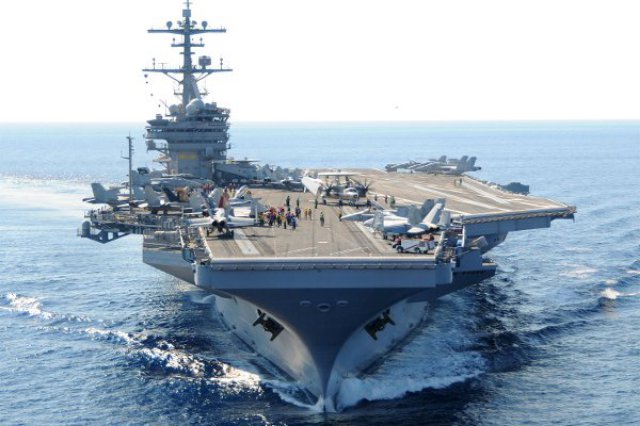
USS George H. W. Bush (U.S. Navy photo)
Visits from Iranian unmanned aerial vehicles designed for surveillance have become commonplace here, where the Bush and ships from its strike group patrol and launch airstrikes on Islamic State targets in Iraq and Syria.
While small Iranian vessels continue to approach the carrier and harass U.S. ships elsewhere in the region, the spy drones appear more regularly, said Capt. Will Pennington, commanding officer of the Bush.
“That is a capability that the entire world is getting, and Iran is no different,” he told Military.com in an interview. “These aren’t small, radio-controlled drones. They’re reconnaissance.”
The first recent reported incident in which Iran flew a drone over a U.S. carrier came in January 2016, when an unarmed reconnaissance UAV approached the Harry S. Truman and a French carrier, the Charles DeGaulle. In that incident, a Navy MH-60 helicopter was launched to investigate, ultimately determining that the unmanned aircraft posed no threat, according to reports.
Now, Pennington said, the Bush detects nearby Iranian drones nearly every day, and crew members have a variety of methods at their disposal to thwart them — and other episodes of Iranian harassment — and protect the ship.
“We almost always have a substantial heads-up,” Pennington said. “And then we have a series of procedures that we train to that gradually, or not gradually, escalates our defensive position and our level of readiness.”
In addition to helicopters that can take to the air for the ship’s defense, the carrier can get support from its escort ships, including the Danish frigate Peter Willemoes, which has been deployed with the carrier strike group since January. There are also built-in defense systems native to the carrier, Pennington said.
When the carrier transited through the Strait of Hormuz and entered the Gulf in late March with four ships from its strike group, it was met with naked hostility in the form of two waves of Iranian fast-attack boats. The crews could be seen manning and arming the weapons aboard, Pennington said. In that case, the Bush deployed helicopters to hover over the boats, and the encounter ended without a military confrontation.
Since arriving in the Gulf, the carrier’s encounters with Iranian boats and UAVs have been less dramatic. Because the ship is patrolling international waters, Iranian vessels are within their rights to operate nearby. Encounters in the region have so far been professional.
But Pennington and carrier leadership remain wary.
Just days ago, Pennington said, the carrier was approached by “a number” of Iranian ships, and their intentions did not appear clear. So the ship escalated its defensive posture, launching helicopters until the strike group was reassured that the ships were not threatening.
There’s a reason even seemingly minor encounters cause the ship to raise its defenses, he said.
“We can’t allow ourselves to be a boiled frog,” Pennington explained, referring to an anecdote in which a frog is placed in cold water which is then slowly heated until the frog dies.
“We have to treat each day as an open mind, and while it’s important to categorize patterns, any day could be the day,” he said. “It’s important to understand what’s routine, but you can’t afford to be lackadaisical. You’ve got to respect the capability that is resident in a country that has demonstrated they’re willing to support and participate in bad behaviour.”
That said, it would likely take much more provocation before the carrier would use military force to end one of the almost-daily drone encounters.
“We always have the inherent right of self-defense. I can tell you we are not in a position nor are we directed to absorb the first shot,” Pennington said. “But [to take action] pre-emptively, it would take a dramatic change in the strategic environment.”
Source: Military.com
